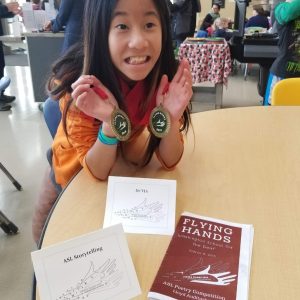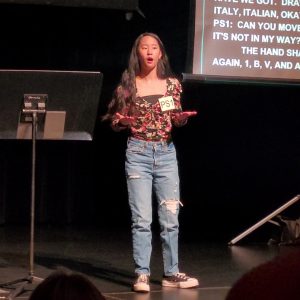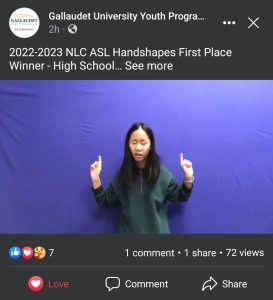By Joy Santos
My daughter, Teanna, participated in her first American Sign Language Literary Competition when she was in the 4th grade. She has been a student at the BC Provincial School for the Deaf since Kindergarten. “Flying Hands” is an American Sign Language Competition that is hosted annually by the Washington School for the Deaf, where elementary students from Deaf Schools in the United States and Canada are encouraged to join.
I accompanied her on her first out-of-province trip to support her and be a part of the audience, and, to my delight, it was here that I was introduced to the world of visual literature. We are from the Philippines, and if there is one well-known fun fact about Filipinos, it is how enjoyment in showcasing talents through performance is deeply ingrained in our culture. Be it karaoke, dance, skits, recitations, and the like, you can always expect to see something as a form of entertainment at any Filipino gathering.
When Teanna was first identified as Deaf in 2008, one of the many things I was curious about was if there was such a thing as Deaf performance. Through my journey of raising her, I learned about the different types of Deaf literature. There are, of course, written works and signed presentations or narratives. What was new to me were the ways storytelling and poetry could be presented in Sign Language.
Some categories of visual literature I’ve seen are:
- ASL Handshape Stories
- ABC Stories: Each word or gesture in the story uses an ASL handshape from A-Z, in consecutive order.
- Number Stories: Each word or gesture in the story uses an ASL handshape that corresponds to a number, in consecutive order.
- Classifier Stories: Classifiers are handshapes in Sign Language used to describe classes such as size and shape. In a classifier story, 2-3 classifiers are used to tell a story. In competitions, these handshapes constraints are predetermined in the guidelines, and sometimes, the participant is allowed to add an additional 1-2 handshapes.
- ASL Poetry
- Personification: Similar to how it is used in English literature, personification is when a concept or inanimate object is given human attributes, and is acted out as such. Handshape constraints are usually also given.
- Percussion Signing: Signing to rhythm. I personally find these comparable to cheers and chants.
ASL literature has been taught in Teanna’s ASL/Deaf Studies classes throughout her school years. She and her classmates are given opportunities to develop their ASL literary skills. Students are informed of upcoming competitions they can participate in.
There is an annual competition hosted by the Provincial Outreach Program: Deaf and Hard of Hearing (POPDHH) called the DHH Proud Showcase. Deaf and Hard of Hearing students from across BC, in both Deaf programs and mainstream schools, are invited to participate. Competition categories usually include presentations (both ASL and oral modalities are accepted), ASL poetry, and DHH art. This event is one that DHH students seem to look forward to each year, as they are able to connect with each other in person, socialize, and form new friendships. It concludes with a “Friendship Day” which is a group field trip to a local attraction.
Another competition that Teanna has been involved in is Gallaudet University’s National Literary Competition. This is held annually, and is open to Deaf students from grades 2-12 across Canada and the United States. Each year, there is a specific theme that contestants must abide by in their submissions. Categories include both ASL and written components.
I feel like my daughter’s involvement in Deaf literary competitions has not only given her a way to artistically express herself, it has also provided a way for her to challenge herself, hone in on her skills for this talent, and allow her to showcase her pride in being a Deaf person.




